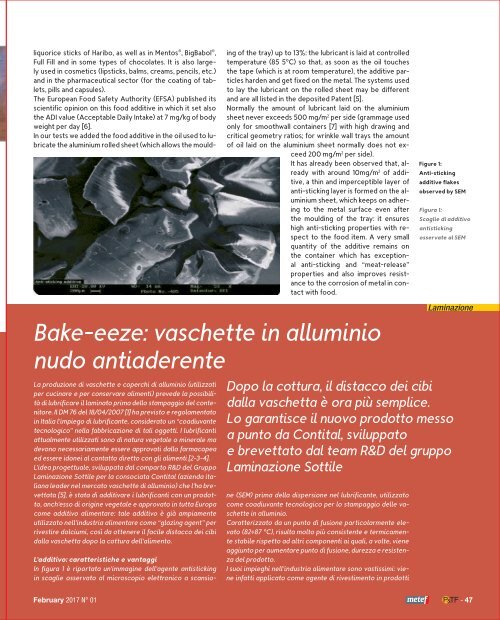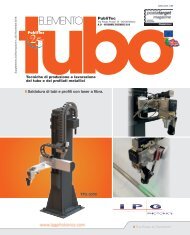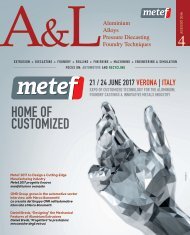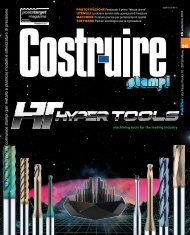sfogliabile_"AL_n1_FEBBRAIO _2017
- No tags were found...
Create successful ePaper yourself
Turn your PDF publications into a flip-book with our unique Google optimized e-Paper software.
0046_0051 2<br />
liquorice sticks of Haribo, as well as in Mentos ® ,BigBabol ® ,<br />
Full Fill and in some types of chocolates. It is also largely<br />
used in cosmetics (lipsticks, balms, creams, pencils, etc.)<br />
and in the pharmaceutical sector (for the coating of tablets,<br />
pills and capsules).<br />
The European Food Safety Authority (EFSA) published its<br />
scientific opinion on this food additive in which it set also<br />
theADIvalue(AcceptableDailyIntake)at7mg/kgofbody<br />
weight per day [6].<br />
In our tests we added the food additive in the oil used to lubricatethealuminiumrolledsheet(whichallowsthemould-<br />
ingofthetray)upto13%:thelubricantislaidatcontrolled<br />
temperature (85 5°C) so that, as soon as the oil touches<br />
the tape (which is at room temperature), the additive particleshardenandgetfixedonthemetal.Thesystemsused<br />
to lay the lubricant on the rolled sheet may be different<br />
and are all listed in the deposited Patent [5].<br />
Normally the amount of lubricant laid on the aluminium<br />
sheet never exceeds 500 mg/m 2 per side (grammage used<br />
only for smoothwall containers [7] with high drawing and<br />
critical geometry ratios; for wrinkle wall trays the amount<br />
of oil laid on the aluminium sheet normally does not exceed<br />
200 mg/m 2 per side).<br />
It has already been observed that, already<br />
with around 10mg/m 2 of additive,<br />
a thin and imperceptible layer of<br />
anti-sticking layer is formed on the aluminium<br />
sheet, which keeps on adhering<br />
to the metal surface even after<br />
the moulding of the tray: it ensures<br />
high anti-sticking properties with respecttothefooditem.Averysmall<br />
quantity of the additive remains on<br />
the container which has exceptional<br />
anti-sticking and “meat-release”<br />
properties and also improves resistance<br />
to the corrosion of metal in contact<br />
with food.<br />
Figure 1:<br />
Anti-sticking<br />
additive flakes<br />
observed by SEM<br />
Figura 1:<br />
Scaglie di additivo<br />
antisticking<br />
osservate al SEM<br />
Bake-eeze: vaschette in alluminio<br />
nudo antiaderente<br />
Laproduzionedivaschetteecoperchidialluminio(utilizzati<br />
per cucinare e per conservare alimenti) prevede la possibilità<br />
di lubrificare il laminato prima dello stampaggio del contenitore.<br />
Il DM 76 del 18/04/2007 [1] ha previsto e regolamentato<br />
in Italia l’impiego di lubrificante, considerato un “coadiuvante<br />
tecnologico” nella fabbricazione di tali oggetti. I lubrificanti<br />
attualmente utilizzati sono di natura vegetale o minerale ma<br />
devono necessariamente essere approvati dalla farmacopea<br />
edessereidoneialcontattodirettoconglialimenti[2-3-4].<br />
L’idea progettuale, sviluppata dal comparto R&D del Gruppo<br />
Laminazione Sottile per la consociata Contital (azienda italiana<br />
leader nel mercato vaschette di alluminio) che l’ha brevettata<br />
[5], è stata di additivare i lubrificanti con un prodotto,<br />
anch’esso di origine vegetale e approvato in tutta Europa<br />
come additivo alimentare: tale additivo è già ampiamente<br />
utilizzato nell’industria alimentare come “glazing agent” per<br />
rivestiredolciumi,cosìdaottenereilfaciledistaccodeicibi<br />
dalla vaschetta dopo la cottura dell’alimento.<br />
L’additivo: caratteristiche e vantaggi<br />
Infigura1èriportataun’immaginedell’agenteantisticking<br />
in scaglie osservato al microscopio elettronico a scansione(SEM)primadelladispersionenellubrificante,utilizzato<br />
come coadiuvante tecnologico per lo stampaggio delle vaschette<br />
in alluminio.<br />
Caratterizzato da un punto di fusione particolarmente elevato<br />
(82÷87 °C), risulta molto più consistente e termicamente<br />
stabile rispetto ad altri componenti ai quali, a volte, viene<br />
aggiuntoperaumentarepuntodifusione,durezzaeresistenza<br />
del prodotto.<br />
I suoi impieghi nell’industria alimentare sono vastissimi: vieneinfattiapplicatocomeagentedirivestimentoinprodotti<br />
Laminazione<br />
Dopo la cottura, il distacco dei cibi<br />
dalla vaschetta è ora più semplice.<br />
Lo garantisce il nuovo prodotto messo<br />
a punto da Contital, sviluppato<br />
e brevettato dal team R&D del gruppo<br />
Laminazione Sottile<br />
February <strong>2017</strong> N° 01<br />
- 47





